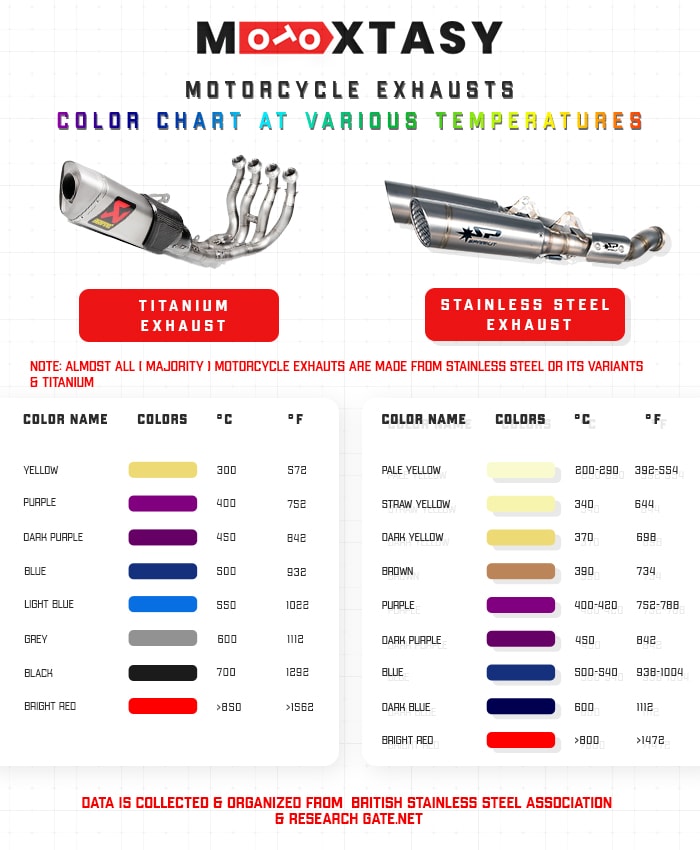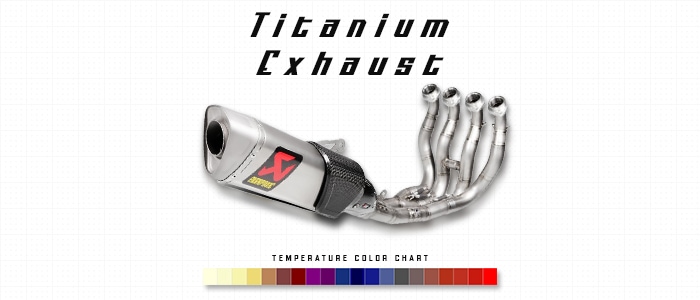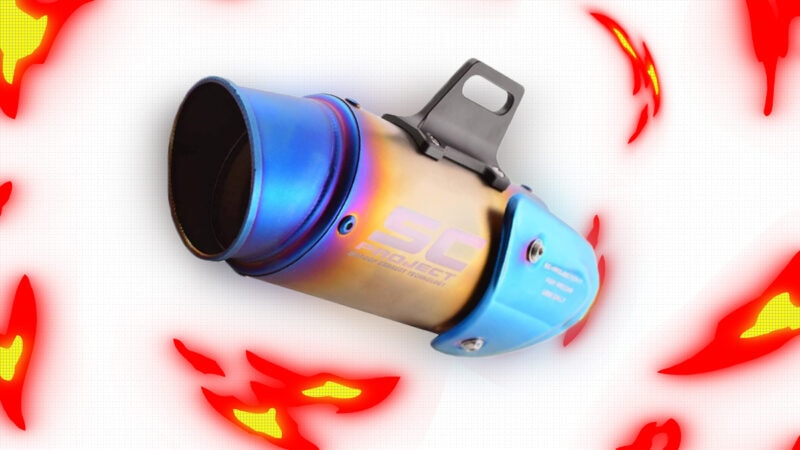Exhaust material of the motorcycle are made up of different types and each of these materials act differently when hot exhaust gases pass through it. The surface temperature of the exhaust can change the color of the exhaust.
Motorcycle exhaust changes its color into blue, yellow, or purple due to high temperatures and also depending upon the material of the exhaust such as stainless steel, titanium, or chrome-plated steel as each material reacts differently to heat causing the metal to oxidize, which can result in variations in color changes. It’s also worth noting that imbalanced fuel mixtures or additives can also affect the color of the exhaust.
In this article you will known everything about motorcycle exhaust changing color and important aspects such as why it happens, what are the causes behind it, how the material of exhaust dictates the color change, and how to prevent it.
Common colors most people can encounter are motorcycle exhaust turning blue or motorcycle exhaust turning yellow, purple, and in rare cases bright red or brown.
First, you should know that the bluing of the exhaust pipe or other colors such as yellow or purple does not harm the motorcycle.
The color of the exhaust does not damage the exhaust system or the motorcycle, but motorcycle exhaust changing color is often linked to inefficient heat transfer from the exhaust which can cause problems for the engine and the exhaust system.
Table of Contents: (Click To Go To The Desired Section Of This Article)
What Colors Do Motorcycle Exhaust Turn Into?
Motorcycle exhaust changing color into multiple shades of different colors is due to the exhaust repeatedly getting heated up as it oxidizes the surface layer and depending on the material the exhaust is made from the color will vary.
So here is an image of a Color chart of motorcycle exhaust changing color at different temperatures.

Here are the 4 colors motorcycle exhaust can turn into after getting hot/high temperature.
1. Motorcycle Exhaust Changing Color Into Blue
Your motorcycle exhaust color can turn blue once the temperature reaches around 500-600 degrees Celsius (900-1120 Fahrenheit) as the result of oxidization of the surface layer of the exhaust due to high temperature.
Whether the exhaust pipe/system is made up of stainless steel or titanium it will turn blue around 500-600 degrees Celsius (900-1120 Fahrenheit).
2. Motorcycle Exhaust Turning Yellow
The motorcycle exhaust pipe turns gold or yellow in color once the temperature reaches around 200-370 degrees Celsius (400-698 Fahrenheit).
As the temperatures rise from low to high the color of the exhaust can go from pale yellow to dark yellow, or golden.
Stainless steel exhaust turns yellow and brown around 200 to 280 degrees Celsius (400-530 Fahrenheit).
Titanium exhausts turn yellow around 300 degrees Celsius ( 572 Fahrenheit).
3. Motorcycle Exhaust Changing Color Into Purple
Motorcycle exhaust turns purple once the temperature reaches around 400-450 degrees Celsius (752-842 Fahrenheit).
Both the titanium and stainless steel motorcycle exhaust changing color takes place within the range of 400-450 degrees Celsius, and the color will be different shades of purple to dark purple.
4. Motorcycle Exhaust Changing Color Into Red
Motorcycle exhaust changing color to red or dark brownish red takes place once the temperature reaches above 600-800 degrees Celsius (1112-1500 Fahrenheit).
And is applicable for both titanium and stainless steel exhaust to turn from dark red/brown to bright red within the range of 600-800 degrees Celsius.
What Causes Motorcycle Exhaust Pipes To Change Its Color?
Motorcycle exhaust pipes undergo discoloration due to high temperatures causing the oxidation of the metal surface of an exhaust pipe.
Other factors such as the material composition of the exhaust such as stainless steel and its variants (mid-steel, ceramic coated steel, etc) or titanium will get discolored at slightly different high/hot temperatures.
So now you know hot exhaust gases which have extremely high temperature causes motorcycle exhaust to change color.
But the question you should be asking is what causes the motorcycle exhaust to get so hot and inefficient in getting rid of the hot gases and maintaining a proper temperature.
So here are the 5 reasons which cause motorcycle exhaust to overheat and change its color.
1. Damage Or Leak In Exhaust Pipe Causes Exhaust To Overheat
Motorcycle exhaust pipes/system is designed to efficiently expel the hot exhaust gases from the motorcycle.
Damage or a leak in the exhaust pipe will cause a concentration of hot exhaust gases at a leaked region causing the exhaust pipe to overheat and end up in motorcycle exhaust changing color into blue, yellow, or purple.
The process of expelling hot exhaust gases efficiently will significantly get poor once the exhaust pipe is damaged or has a leak.
So here’s a quick article on how to fix a motorcycle exhaust leak.
2. Lean Air/fuel Mixture Results In Hot Exhaust Pipe Temperature
Lean air/fuel mixture will introduce less fuel and more air into the engine causing the engine itself and components near the engine to overheat because of air/fuel mixture imbalance.
Out-of-tune carburetor or clogged fuel injector are one of the major causes behind the imbalance in air/fuel mixture.
Lean air/fuel mixture will overheat the engine and exhaust system so might be able to see exhaust pipe discoloration more near the exhaust headers which are closer to the engine. So motorcycle exhaust changing color is a direct reaction of lean air/fuel mixture and hot exhaust pipe temperature.
3. Blown Head Gasket Causes Excessive Heat In Exhaust Pipe
A blown head gasket will cause a poor combustion process and cause an imbalance in the air/fuel mixture, which will result in inefficient fuel burning resulting in excessive buildup of heat in the exhaust pipe.
The improper burning of fuel will cause the unburned fuel to get ignited inside the hot exhaust pipe further increasing the temperature of the exhaust system and resulting in motorcycle exhaust changing color.
4. Leaking Valves/Intake Manifold
Leaking valves or intake manifolds will result in compression loss inside the combustion chamber. The ignition of the air/fuel mixture will get poor resulting in exhaust headers and the engine itself running hot.
As you know by now excessive heat buildup inside the exhaust pipe will cause discoloration over time.
5. Bad Spark Plugs Timing
Corrosion/damage or carbon buildup on the spark plugs will cause the fuel to not burn completely and will have a weak or poor spark.
These bad spark plugs will cause the motorcycle engine to operate under high stress as the temperature increases so the exhaust headers which are closest to the engine’s exhaust port will also get heated.
So motorcycle exhaust changing color is a direct correlation between high exhaust temperature and the material it’s made from and the exhaust will either get blue, yellow, or purple.
At What Temperatures Do Exhaust Color Change?
Exhaust color changes to different shades of yellow, blue, purple, or brown/red within the temperature range of 200-800 degree Celsius (392- 1500 Fahrenheit).
Although exhausts are made from different materials, but a majority of widely used exhausts are made up of titanium, stainless steel, and its variants such as mid-steel, and ceramic-coated steel.
Stainless Steel Exhaust Pipe Color Change At Different Temperatures

| Color Name | Degree Celsius (° C) | Fahrenheit (° F) |
|---|---|---|
| Pale Yellow | 200-290 | 392-554 |
| Straw Yellow | 340 | 644 |
| Dark Yellow | 370 | 698 |
| Brown | 390 | 734 |
| Purple | 400-420 | 752-788 |
| Dark Purple | 450 | 842 |
| Blue | 500-540 | 938-1004 |
| Dark Blue | 600 | 1112 |
| Bright Red | >800 | >1472 |
Titanium Exhaust Pipe Color Change At Different Temperatures

| Color Name | Degree Celsius (° C) | Fahrenheit (° F) |
|---|---|---|
| Yellow | 300 | 572 |
| Purple | 400 | 752 |
| Dark Purple | 450 | 842 |
| Blue | 500 | 932 |
| Light Blue | 550 | 1022 |
| Grey | 600 | 1112 |
| Black | 700 | 1292 |
| Bright Red | >850 | >1562 |
How To Remove Motorcycle Exhaust Blue Color & Other Colors?
To remove the Bluing of motorcycle exhaust or any discoloration you can use products such as Bluejob or Autosol bluing remover that are specifically designed to remove any kind of discoloration from the exhaust.
These polishing products deoxidize the surface layer of a discolored motorcycle exhaust pipe and can also remove rust.
Whether your motorcycle has chrome plating on the exhaust or a standard one, Autosol bluing remover will remove all discolorations.
Another way of removing yellow, blue, purple, or any kind of discoloration from the exhaust is getting it buffed and polished by a professional.
Yup, it’s that simple and quick to remove bluing/discoloration from the motorcycle exhaust.
How To Prevent Discoloration Of Motorcycle Exhaust?
Motorcycle exhaust changing color can be easily prevented by applying bluing removal polish once a month and maintaining good engine and exhaust system maintenance to avoid extreme overheating which is the sole reason for motorcycle exhaust discoloration.
Lean air/fuel mixture, vacuum leak, blown head gasket, and bad spark plugs will contribute to overheating of an exhaust. So a maintenance routine is crucial to avoid overheating and discoloration of the exhaust pipe.







